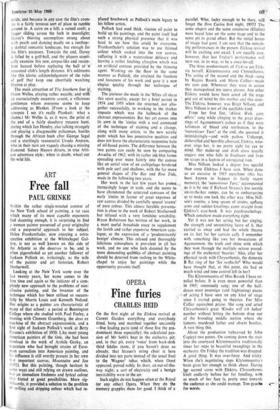Free fall
ART PAUL 'GRINKE
Within the rather single-minded context of the New York school of painting, a rat race which many of its most capable exponents find daunting enough, it is surprising to find a woman painter possessed of great originality and a purposeful approach to her subject. Helen Frankenthaler, now enjoying a retro- spective exhibition at the Whitechapel Gal- lery, is not as well known on this side of the Atlantic as she deserves to be, and is often pigeonholed as yet another follower of Jackson Pollock or, irritatingly, as the wife of the painter and art historian, Robert Motherwell.
Looking at the NeW York scene over the last twenty years, her name comes to the fore time and again as the initiator of a com- pletely new approach to the problems of non= allusive painting, and the inventor of the technique which has been utilised so success- fully by Morris Louis and Kenneth Noland. Her origins as a painter are characteristic of many of that school: a period at Bennington College where she studied with Paul Feeley, a meeting. with- Clement Greenberg, the deus ex machina of the abstract expressionists, and a first sight of Jackson Pollock's work at Betty Parsons's exhibition of 1950. Like most young American painters of the time, she had been involved in the work of Arshile Gorky, an expatriate who had brought strains of Euro- pean surrealism into American painting, and his influence is still overtly present in her own first important canvas, Mountains and Sea (1952). But this painting, though hesitant in some ways and still relying on drawn outlines, had an immediate freshness and lyrical colour that hinted at great possibilities. More sig- nificantly, it provided a solution to the problem of spilling and dripping colour which bad re-
placed brushwork as Pollock's main legacy to his fellow artists.
Pollock had used thick, viscous oil paint to build up his paintings, and the paint itself had such a strong physical presence that it was hard to see bow this could be overcome. Frankenthaler's solution was to use thinned colour which soaked into the raw canvas, suffusing it with a watercolour delicacy and leaving a rather fetching afterglow which was an artificial contour provided by the thinning agent. Working on the floor in the same manner as Pollock, she retained the freedom and looseness of his work and gave it a new elegiac quality through her technique of staining.
The pictures she made in the 'fifties all share this open quality, except for a brief period in 1954 and 1955 when she returned, not alto- gether successfully, to working in the thicker impasto which was the hallmark of the abstract expressionists. But her art comes into its own in the 'sixties with a real command of the technique of staining and a change, along with many artists, to the new acrylic paint which has less penetrative qualities and does not leave the characteristic turpentine halo of oil-based paints. The difference between the two paints can easily be seen by comparing Arcadia, of 1961 with its rather ink-blot forms spreading ever more faintly into the canvas like an aerial view of an archipelago bordered with pale surf and shallows, with the far more general shapes of The Bay and Blue Tide, made in the following two years.
Her work in the last few years has grown, increasingly larger in scale, and she seems to have abandoned the saturated canvases of the early 'sixties in favour of great expanses of raw canvas divided by carefully spaced 'events' of pure colour. This almost heraldic presenta- tion is close to the work of Robert Motherwell but infused with a very feminine sensibility. Bryan Robertson has written of her work, in a most useful broadside essay to supplement the lavish and rather expensive American cata- logue, as the expression of a 'predominantly benign' climate. This relaxed and thoroughly felicitous atmosphere is prevalent in all her work, and no one who feels daunted by the more demanding quibbles of abstract painting should be deterred from rushing to the White- chapel to enjoy her paintings while the opportunity presents itself.






































 Previous page
Previous page